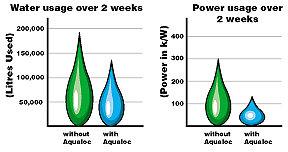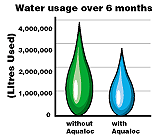

Aqualoc
is a modular construction and consists of two parts, the base which sits
in and on the tap seat and a jumper valve which regulates the flow of
water.
The jumper valve varies in diameter providing a range of flow rates catering from gravity fed systems to high pressure. Flow rates up to 84% reduction are available, and when the recommended models are installed in most situations water consumption costs are reduced by up to 45%. Entities who also pay for waste water costs, can often add another 20%-25% on this figure from savings on sewerage usage.
By reducing water consumption Aqualoc reduces energy required for heating hot water, power cost reduction can be up to 60% with savings in CO2 emissions as a result.
Case
Studies:
Case
study 1
water & power savings in high usage home
Case
study 2
water & power savings in accomodation using electric hot water
Case
study 3
water & power savings in 28 homes using electric hot water

Aqualoc's patented multi-ridging 'O' ring system within the base of the valve provides a unique seal on the seat of a tap, which eliminates leaking taps. Apart from the direct water (and often energy) savings of sealing a dripping tap, maintenance costs are also reduced. When installed by a licensed plumber, Aqualoc comes with a 5 year guarantee. With water and energy savings often offsetting the cost of the Aqualoc, the associated maintenance savings from nil washer changes can be huge.
An inexpensive alternative to ceramic cartridges, The Aqualoc Tap Valve design creates a vacuum, rendering even the oldest, stiffest taps very easy to turn on and off.
Water
& Power Readings
NSW Government Dept. (high usage home using electric hot water)
27%
Water Saving
55% Power Saving
This equates to $1,912 in water savings each year (based on 40c/Kl & 45c/Kl sewerage usage cost) $1609 in power savings each year (based on 8.6c/kWh) Savings of 17.2 tonnes of CO2 each year

Water
Readings & Power Savings
Federal Government Dept.
(accommodation using electric hot water)
36%
Water Saving
(Based on 25% hot water usage)
Savings of $1609 on energy
17.2 tonnes of CO2 on
energy
Payback period = 0.8 years
This equates to $1,190 in water savings each year (based on 92c/Kl) $445.30 in power savings each year (based on 10.38c/kWh) Savings of 4.29 tonnes of CO2 each year. Equivalent to the emissions from a typical car driving 12,800km.

Water
& Power Readings (seasonally comparative)
Interstate Government Dept. (28 homes using electric hot water)
23.9%
Water Saving
(Based on 50% hot water usage)
Savings of $2744 on energy
29 tonnes of CO2 saved/yr
Payback period = 1.9 years
This equates to $737 in water savings each year ($26.32 per home, per yr) (based on 40c/Kl) $2,744 in power savings each year ($98 per home, per yr) (based on 8.6c/kWh) Savings of 29 tonnes of CO2 each year. (1.04 tonnes of CO2 per home, per yr)
